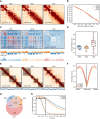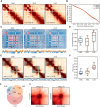Cell cycle arrest explains the observed bulk 3D genomic alterations in response to long-term heat shock in K562 cells
- PMID: 35835565
- PMCID: PMC9341516
- DOI: 10.1101/gr.276554.122
Cell cycle arrest explains the observed bulk 3D genomic alterations in response to long-term heat shock in K562 cells
Abstract
Heat shock is a common environmental stress, although the response of the nucleus to it remains controversial in mammalian cells. Acute reaction and chronic adaptation to environmental stress may have distinct internal rewiring in the gene regulation networks. However, this difference remains largely unexplored. Here, we report that chromatin conformation and chromatin accessibility respond differently in short- and long-term heat shock in human K562 cells. We found that chromatin conformation in K562 cells was largely stable in response to short-term heat shock, whereas it showed clear and characteristic changes after long-term heat treatment with little alteration in chromatin accessibility during the whole process. We further show in silico and experimental evidence strongly suggesting that changes in chromatin conformation may largely stem from an accumulation of cells in the M stage of the cell cycle in response to heat shock. Our results represent a paradigm shift away from the controversial view of chromatin response to heat shock and emphasize the necessity of cell cycle analysis when interpreting bulk Hi-C data.
© 2022 Xu et al.; Published by Cold Spring Harbor Laboratory Press.
Figures





Similar articles
-
Genome-wide chromatin remodeling modulates the Alu heat shock response.Gene. 2001 Oct 3;276(1-2):127-33. doi: 10.1016/s0378-1119(01)00639-4. Gene. 2001. PMID: 11591479
-
Transcriptional response to stress in the dynamic chromatin environment of cycling and mitotic cells.Proc Natl Acad Sci U S A. 2013 Sep 3;110(36):E3388-97. doi: 10.1073/pnas.1305275110. Epub 2013 Aug 19. Proc Natl Acad Sci U S A. 2013. PMID: 23959860 Free PMC article.
-
Transcriptional regulation and binding of heat shock factor 1 and heat shock factor 2 to 32 human heat shock genes during thermal stress and differentiation.Cell Stress Chaperones. 2004 Mar;9(1):21-8. doi: 10.1379/481.1. Cell Stress Chaperones. 2004. PMID: 15270074 Free PMC article.
-
[Advances in mammalian three-dimensional genome by using Hi-C technology approach].Yi Chuan. 2019 Mar 20;41(3):215-233. doi: 10.16288/j.yczz.18-317. Yi Chuan. 2019. PMID: 30872258 Review. Chinese.
-
The heat shock response: A case study of chromatin dynamics in gene regulation.Biochem Cell Biol. 2013 Feb;91(1):42-8. doi: 10.1139/bcb-2012-0075. Epub 2013 Feb 13. Biochem Cell Biol. 2013. PMID: 23442140 Review.
Cited by
-
Epigenomic insights into the immune regulatory mechanism of GBP4L in poultry.Poult Sci. 2025 Jul;104(7):105172. doi: 10.1016/j.psj.2025.105172. Epub 2025 Apr 22. Poult Sci. 2025. PMID: 40435797 Free PMC article.
-
Crosslinking intensity modulates the reliability and sensitivity of chromatin conformation detection at different structural levels.Commun Biol. 2024 Sep 30;7(1):1216. doi: 10.1038/s42003-024-06904-0. Commun Biol. 2024. PMID: 39349577 Free PMC article.
-
Cellular senescence in cancer: molecular mechanisms and therapeutic targets.MedComm (2020). 2024 Apr 24;5(5):e542. doi: 10.1002/mco2.542. eCollection 2024 May. MedComm (2020). 2024. PMID: 38660685 Free PMC article. Review.
-
A comprehensive benchmarking with interpretation and operational guidance for the hierarchy of topologically associating domains.Nat Commun. 2024 May 23;15(1):4376. doi: 10.1038/s41467-024-48593-7. Nat Commun. 2024. PMID: 38782890 Free PMC article.
-
Disentangling spatial organization and splicing of rare intron classes in the human genome.bioRxiv [Preprint]. 2025 Aug 15:2025.08.11.669784. doi: 10.1101/2025.08.11.669784. bioRxiv. 2025. PMID: 40832269 Free PMC article. Preprint.
References
Publication types
MeSH terms
Substances
LinkOut - more resources
Full Text Sources
